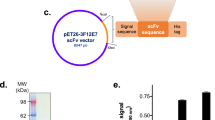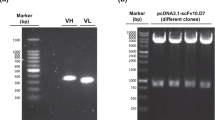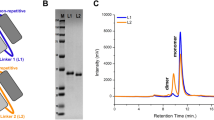Abstract
Single-chain antibodies (scFv) have an enormous potential for clinical application. However, rapid blood clearance and difficulties in large-scale production of active scFvs have limited the practical use of these antibody fragments. Recently, an anti-vascular endothelial growth factor (VEGF) scFv (scFv V65) was selected in our laboratory from a human antibody phage-display library. This antibody was able to reduce tumor growth in mice by approximately 50%. Here, we employ a gene therapy strategy for sustained in vivo expression of scFv V65 and its derivatives. scFv fusion proteins containing parts of the constant IgG1 region were generated (minibody and scFv V65–Fc) to increase the serum half-life of the scFv V65. Systemic administration of recombinant adenovirus encoding scFv V65 resulted in substantial tumor inhibition. This effect could be improved by multiple virus injections. We found that the efficacy of different scFv V65 formats was dependent on the mode of administration: whereas scFv V65–Fc was the most efficient when expressed locally, scFv V65 was superior when delivered systemically. Our results show that therapeutic levels of scFv V65 can be obtained by systemic injection of recombinant adenoviruses. Therefore, therapeutic gene delivery of scFv is a feasible strategy that overcomes several limitations of conventional antibody therapy.
This is a preview of subscription content, access via your institution
Access options
Subscribe to this journal
Receive 12 print issues and online access
$259.00 per year
only $21.58 per issue
Buy this article
- Purchase on Springer Link
- Instant access to full article PDF
Prices may be subject to local taxes which are calculated during checkout






Similar content being viewed by others
References
Folkman J . Seminars in Medicine of the Beth Israel Hospital, Boston. Clinical applications of research on angiogenesis. N Engl J Med 1995; 333: 1757–1763.
Ferrara N et al. The vascular endothelial growth factor family of polypeptides. J Cell Biochem 1991; 47: 211–218.
Ferrara N . VEGF: an update on biological and therapeutic aspects. Curr Opin Biotechnol 2000; 11: 617–624.
Shibuya M et al. Nucleotide sequence and expression of a novel human receptor-type tyrosine kinase gene (flt) closely related to the fms family. Oncogene 1990; 5: 519–524.
de Vries C et al. The fms-like tyrosine kinase, a receptor for vascular endothelial growth factor. Science 1992; 255: 989–991.
Hasan J, Jayson GC . VEGF antagonists. Expert Opin Biol Ther 2001; 1: 703–718.
Winter G, Griffiths AD, Hawkins RE, Hoogenboom HR . Making antibodies by phage display technology. Annu Rev Immunol 1994; 12: 433–455.
8Huston JS et al. Protein engineering of antibody binding sites: recovery of specific activity in an anti-digoxin single-chain Fv analogue produced in Escherichia coli. Proc Natl Acad Sci USA 1988; 85: 5879–5883.
Yokota T et al. Microautoradiographic analysis of the normal organ distribution of radioiodinated single-chain Fv and other immunoglobulin forms. Cancer Res 1993; 53: 3776–3783.
Vitaliti A et al. Inhibition of tumor angiogenesis by a single-chain antibody directed against vascular endothelial growth factor. Cancer Res 2000; 60: 4311–4314.
Feldman AL, Libutti SK . Progress in antiangiogenic gene therapy of cancer. Cancer 2000; 89: 1181–1194.
Chen QR, Zhang L, Gasper W, Mixson AJ . Targeting tumor angiogenesis with gene therapy. Mol Genet Metab 2001; 74: 120–127.
Reff ME, Heard C . A review of modifications to recombinant antibodies: attempt to increase efficacy in oncology applications. Crit Rev Oncol Hematol 2001; 40: 25–35.
Borsi L et al. Selective targeting of tumoral vasculature: comparison of different formats of an antibody (L19) to the ED-B domain of fibronectin. Int J Cancer 2002; 102: 75–85.
Hardy S et al. Construction of adenovirus vectors through Cre–lox recombination. J Virol 1997; 71: 1842–1849.
Vajkoczy P et al. Microtumor growth initiates angiogenic sprouting with simultaneous expression of VEGF, VEGF receptor-2, and angiopoietin-2. J Clin Invest 2002; 109: 777–785.
Gabrilovich DI et al. Production of vascular endothelial growth factor by human tumors inhibits the functional maturation of dendritic cells. Nat Med 1996; 2: 1096–1103.
Gabrilovich DI et al. Antibodies to vascular endothelial growth factor enhance the efficacy of cancer immunotherapy by improving endogenous dendritic cell function. Clin Cancer Res 1999; 5: 2963–2970.
Wong AK et al. Excessive tumor-elaborated VEGF and its neutralization define a lethal paraneoplastic syndrome. Proc Natl Acad Sci USA 2001; 98: 7481–7486.
Colcher D et al. In vivo tumor targeting of a recombinant single-chain antigen-binding protein. J Natl Cancer Inst 1990; 82: 1191–1197.
Ghetie V, Ward ES . FcRn: the MHC class I-related receptor that is more than an IgG transporter. Immunol Today 1997; 18: 592–598.
Ober RJ, Radu CG, Ghetie V, Ward ES . Differences in promiscuity for antibody–FcRn interactions across species: implications for therapeutic antibodies. Int Immunol 2001; 13: 1551–1559.
Neri D et al. Targeting by affinity-matured recombinant antibody fragments of an angiogenesis associated fibronectin isoform. Nat Biotechnol 1997; 15: 1271–1275.
Pini A et al. Hierarchical affinity maturation of a phage library derived antibody for the selective removal of cytomegalovirus from plasma. J Immunol Methods 1997; 206: 171–182.
Lam PY, Breakefield XO . Hybrid vector designs to control the delivery, fate and expression of transgenes. J Gene Med 2000; 2: 395–408.
Morral N et al. Administration of helper-dependent adenoviral vectors and sequential delivery of different vector serotype for long-term liver-directed gene transfer in baboons. Proc Natl Acad Sci USA 1999; 96: 12816–12821.
Reynolds PN et al. Combined transductional and transcriptional targeting improves the specificity of transgene expression in vivo. Nat Biotechnol 2001; 19: 838–842.
Trepel M, Arap W, Pasqualini R . In vivo phage display and vascular heterogeneity: implications for targeted medicine. Curr Opin Chem Biol 2002; 6: 399–404.
Gupta VK et al. Vascular endothelial growth factor enhances endothelial cell survival and tumor radioresistance. Cancer J 2002; 8: 47–54.
Browder T et al. Antiangiogenic scheduling of chemotherapy improves efficacy against experimental drug-resistant cancer. Cancer Res 2000; 60: 1878–1886.
Klement G et al. Continuous low-dose therapy with vinblastine and VEGF receptor-2 antibody induces sustained tumor regression without overt toxicity. J Clin Invest 2000; 105: R15–R24.
Arafat WO et al. Effective single chain antibody (scFv) concentrations in vivo via adenoviral vector mediated expression of secretory scFv. Gene Therapy 2002; 9: 256–262.
Sanz L et al. Single-chain antibody-based gene therapy: inhibition of tumor growth by in situ production of phage-derived human antibody fragments blocking functionally active sites of cell-associated matrices. Gene Therapy 2002; 9: 1049–1053.
Fallaux FJ et al. Characterization of 911: a new helper cell line for the titration and propagation of early region 1-deleted adenoviral vectors. Hum Gene Ther 1996; 7: 215–222.
Klemenz R, Hoffmann S, Werenskiold AK . Serum- and oncoprotein-mediated induction of a gene with sequence similarity to the gene encoding carcinoembryonic antigen. Proc Natl Acad Sci USA 1989; 86: 5708–5712.
Jonsson U et al. Real-time biospecific interaction analysis using surface plasmon resonance and a sensor chip technology. Biotechniques 1991; 11: 620–627.
Halin C et al. Tumor targeting properties of antibody-VEGF fusion proteins. Int. J. Cancer 2002; 102: 109–116.
Acknowledgements
This work was supported by Swiss National Foundation NFP37, Grant 40-44820.95 (to RK) and by the donation of an anonymous client of the United Bank of Switzerland.
We are very grateful to Professor Ph. U Heitz for support of this project. We thank Alain Lamarre for a helpful discussion and Cornelia Halin for providing us with the anti-ED-B scFv L19–VEGF164 fusion protein used in a BIAcore assay.
Author information
Authors and Affiliations
Rights and permissions
About this article
Cite this article
Afanasieva, T., Wittmer, M., Vitaliti, A. et al. Single-chain antibody and its derivatives directed against vascular endothelial growth factor: application for antiangiogenic gene therapy. Gene Ther 10, 1850–1859 (2003). https://doi.org/10.1038/sj.gt.3302085
Received:
Accepted:
Published:
Issue Date:
DOI: https://doi.org/10.1038/sj.gt.3302085
Keywords
This article is cited by
-
State of play and clinical prospects of antibody gene transfer
Journal of Translational Medicine (2017)
-
Hyperactivation of retina by light in mice leads to photoreceptor cell death mediated by VEGF and retinal pigment epithelium permeability
Cell Death & Disease (2013)
-
Inhibition of tumor growth in vivo by in situ secretion of bispecific anti-CEA × anti-CD3 diabodies from lentivirally transduced human lymphocytes
Cancer Gene Therapy (2007)
-
Engineered antibody fragments and the rise of single domains
Nature Biotechnology (2005)



